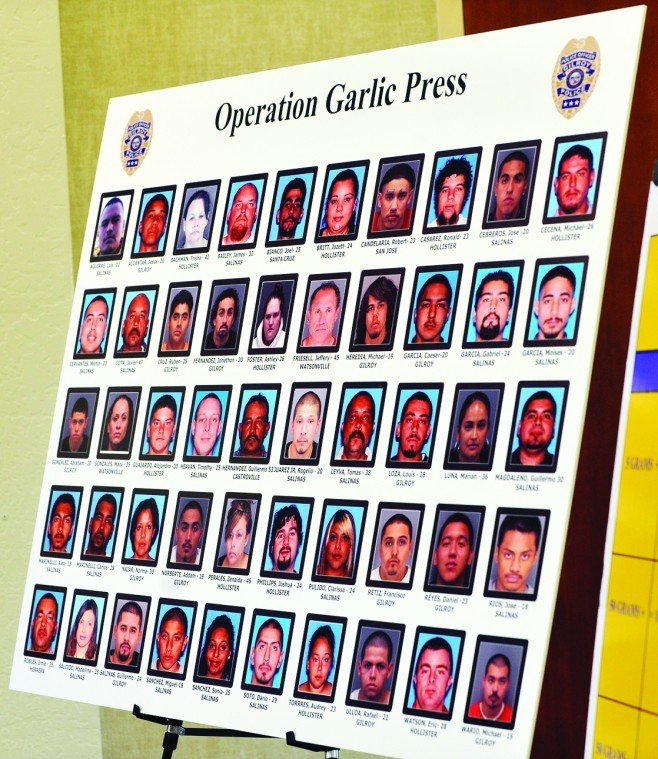Last fall, Gilroy Police wrapped up the 39-agency, 16-month undercover sting known as Operation Garlic Press that culminated with a four-day arrest blitz of 118 suspects – and one year later, police say Gilroy streets are safer.
“There was a time not too long ago that gang members would have the red hat, the red jersey, the red shorts and shoes, and walk down the street in packs, almost asking law enforcement to challenge them,” said Police Sgt. Joseph Deras, who led the undercover operation.
All that changed, Deras said, after Operation Garlic Press in October 2011, and the counterpart sting it inspired, Operation Royal Flush in December 2011, which specifically targeted Gilroy’s gang population.
“From our perspective, the visible gang presence is virtually nonexistent, and we see significantly less violent crimes,” he said.
Pointing to a few violent gang-related crimes over the summer – a screwdriver stabbing in July near South Valley Middle School, a drive-by shooting on Westwood Drive in August – Deras said sporadic gang-related crime is still apparent in Gilroy, but not to the level it was pre-OGP.
“Criminals realized their high profile posture wasn’t working here,” he said.
With very few suspects from OGP back on the streets (about three of the 118 arrested are out of custody, Deras said), the criminal and gang culture in Gilroy has taken a break to metaphorically lick their wounds.
“All these years those guys were carrying on about their crime, and now they are taking a second look,” he said.
According to data from the GPD, most categories of crime dropped in the six months following OGP compared with the time span in the previous year. From October 2011 through March 2012, there were 45 cases of aggravated assault, compared to 57 in October to March the previous years. Auto theft dropped slightly from 105 cases to 95. Reports of larceny dropped from 644 to 487.
But now is not the time for law enforcement to kick back, either. With criminals laying low right now, Deras said Gilroy could be vulnerable to new thugs stepping in for the chance to take charge of the lucrative field of selling narcotics and stolen cars.
“We have to keep putting the pressure on. The minute they draw attention, we address it immediately so it doesn’t become an issue,” he said.
Currently, the Anti-Crime Team is focused on narcotics crimes as well as holding people on supervised release accountable by doing regular probation sweeps.
Forty-seven of the suspects from OGP arrests went to federal court – many of whom have been sentenced already – with prison sentences ranging from 9 months on the low end, to 20 years and beyond.
Morgan Hill resident Adrian Gamino, 31, was sentenced in March to 20 years in federal prison and 10 years supervised release for three counts of distribution of methamphetamine after being caught on camera selling meth to undercover officers during OGP. His co-conspirator, Miguel Gonzalez, 37 of Salinas, received the same sentence for similar counts of meth distribution.
In state court, 27 suspects, representing 86 counts including attempted murder, shooting at an occupied dwelling, various drug and weapons violations, many with gang enhancements, will begin trial Oct. 1, according to Frank Carrubba, deputy district attorney.
For the course of the 18-month operation, Gilroy Police ran a store known as Bobby’s Place, a windowless warehouse with no sign at 6700 Brem Lane near Garlic City RV Park, which built a reputation in the region’s criminal underworld as an oasis for illegal sales.
Through the undercover officer who posed as “Bobby,” a tough, muscle shirt-wearing crime lord, Gilroy Police bought 87 stolen vehicles, 47 illegal firearms, three pounds of methamphetamine, 28.5 grams of heroin as well as marijuana, cocaine and ecstasy from unsuspecting criminals, 51 of them known gang members.
All transactions were captured on camera and eventually used as evidence.
OGP put Gilroy law enforcement “on the map,” Deras said. When the completion of OGP was announced last October, the news of a large-scale undercover operation in a small town like Gilroy was picked up by media all over the state. Kamala Harris, attorney general for the California Department of Justice came to a press conference at a packed City Hall to congratulate the GPD on the operation’s success.
With a 95 percent successful sales-to-arrest rate, compared with 50 percent at similar operations around the state, OGP drew attention from law enforcement agencies all over California, and has become somewhat of a model for other agencies, Deras said.
In April, GPD received an award in investigative excellence from California’s Commission on Peace Officer Standards and Training, the state’s main law enforcement training agency. A copy of the award hangs in Deras’ office in the Anti-Crime Team department today.
OGP worked so well because of the cooperative spirit from all agencies involved, Deras said.
“We have a history of working well with our partners. Operation Garlic Press wasn’t ego-driven in any way, which is usually a huge issue in law enforcement. Everyone wants credit,” he said. “Yes it was a GPD case, but it was about everyone involved.”
City Administrator Tom Haglund said that the operation has been “hugely successful” in curbing criminal activity in Gilroy, and is proud of the many officers who made it possible.
But Haglund agreed that now is not the time for the city to rest on its laurels.
“Operation Garlic Press and Operation Royal Flush were so stunningly effective, we had to step in and make sure that someone else doesn’t step in and fill that vacuum,” Haglund said. “That will be something that we have to do for every day of every month of every year, for forever probably.”
Gilroy City Council founded the South County Youth Task Force in March, which unites the law enforcement agencies in Gilroy and Morgan Hill, along with corresponding school districts, the Sheriff’s Department, the Santa Clara County District Attorney’s Office, and various youth-centered nonprofits to share information and deter youth from entering gang-related criminal activity. The task force shares information about specific juveniles in Gilroy and Morgan Hill who may be dabbling in criminal activity so law enforcement and the school districts are on the same page about what groups of teens in Gilroy are most at-risk.
“You need agencies like the court system and nonprofit partners to work together, so you don’t duplicate something someone else is already doing, but instead use each resource they have to offer in a very effective way,” Haglund said.
Noting that Gilroy’s generational crime problem is a “tough case to crack,” Haglund said moving forward, the city should focus on keeping youth out of trouble.
“What we need to concentrate on now is prevention,” he said. “It’s all about improving people’s lives and giving alternatives to a life of crime.”
Police Chief Denise Turner agreed – without letting off any pressure on known gang members or current repeat criminals, the department is moving their focus to identifying at-risk youth with ties to criminal families, and preventing them from entering that life.
“Prevention and intervention is our motto for this year,” Turner said.
Turner said she is proud of the department for the success of OGP, but what matters most to her is that the community can see a difference.
“I hope that the community is seeing less gang activity, that people aren’t afraid to take a walk in the evening in the park,” she said. “Those are the real indicators that we are doing the right thing.”














